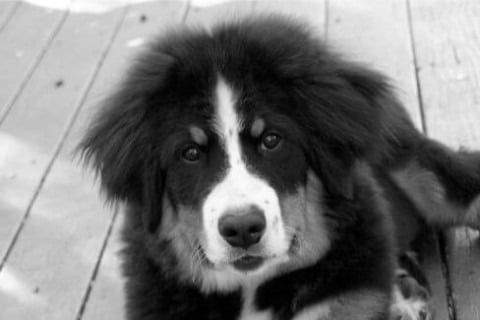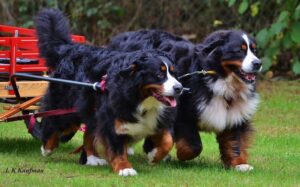
Bernese Mountain Dogs and Draft Work
Explore the draft heritage of the Bernese Mountain Dog. Learn how to start: Draft tests, drafting equipment such as carts, harnesses and more.
Home » Meet The Breeds » Bernese Mountain Dog
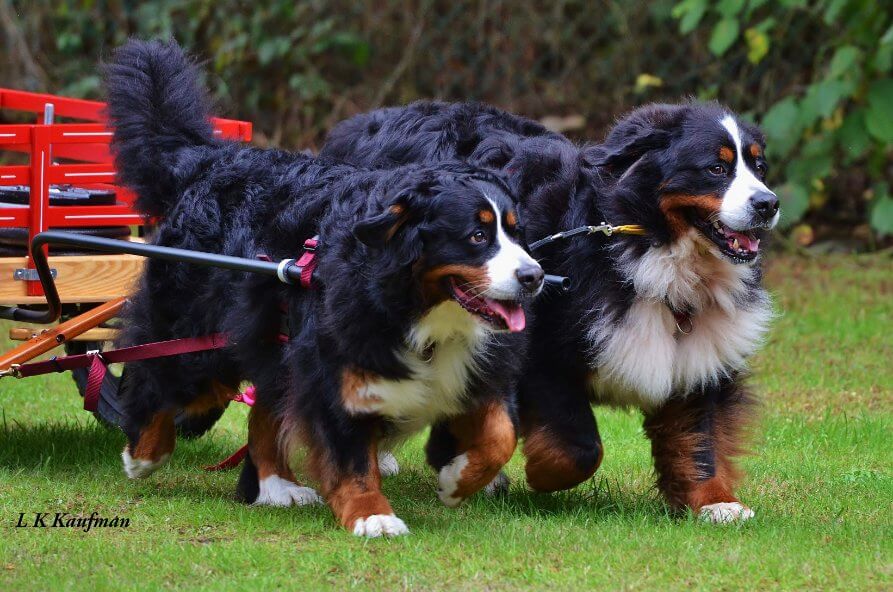
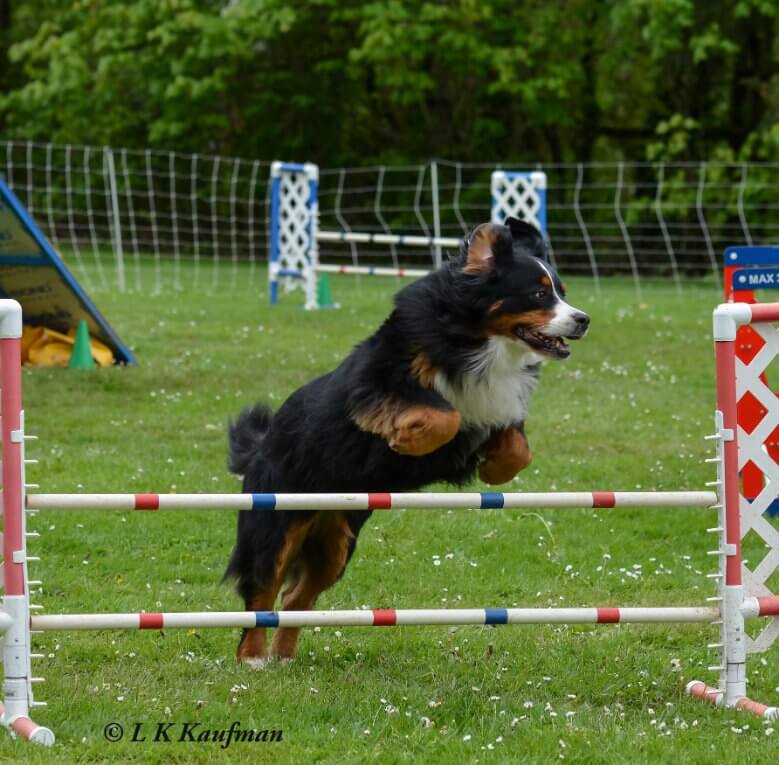

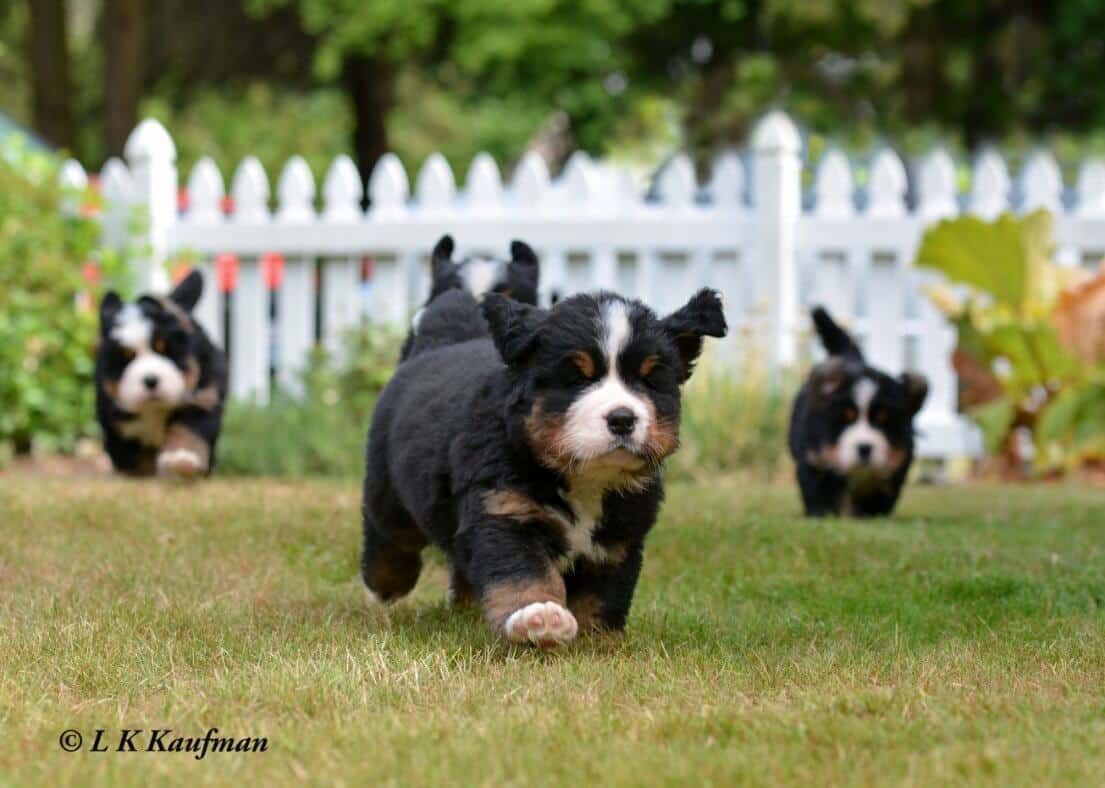
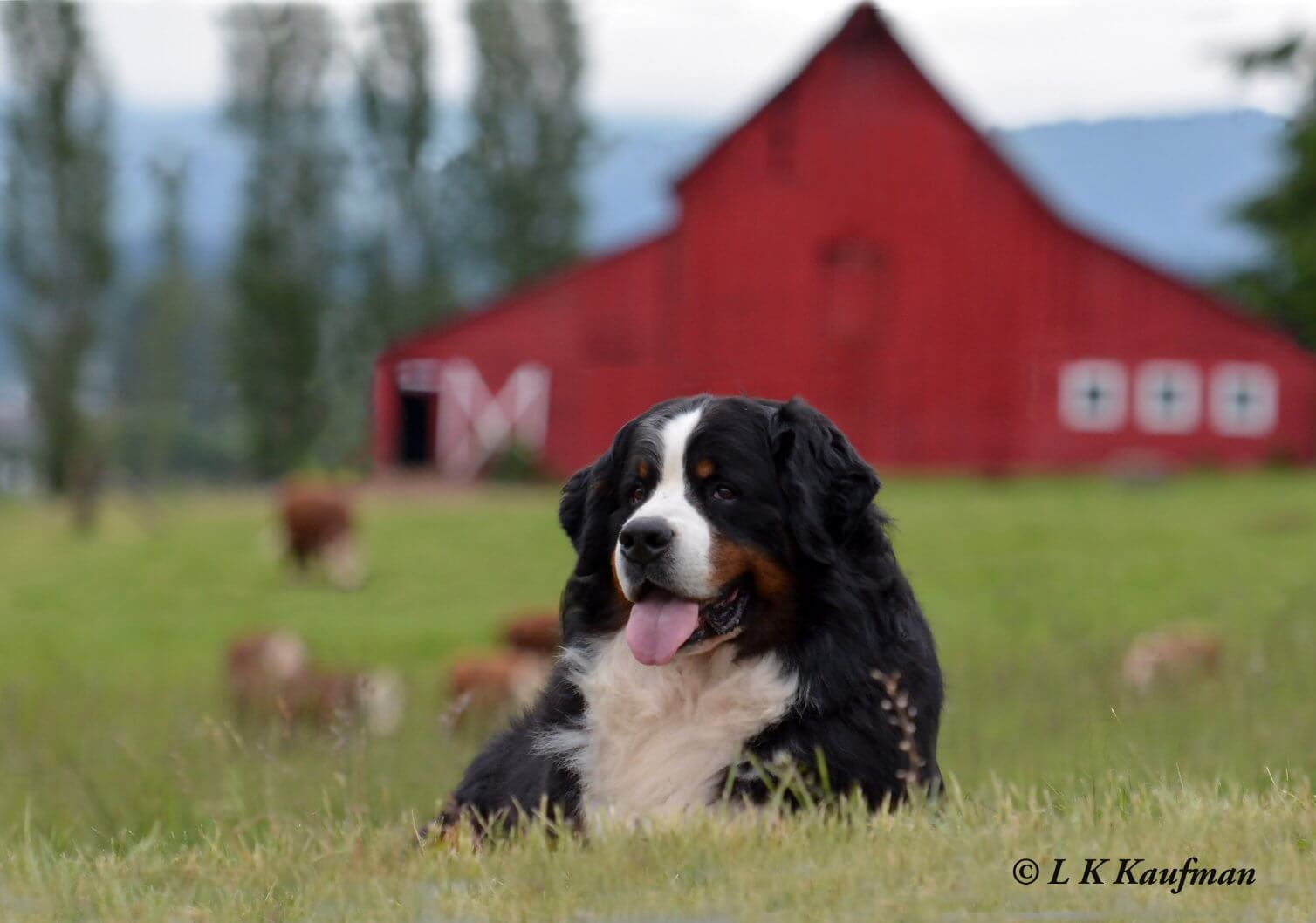
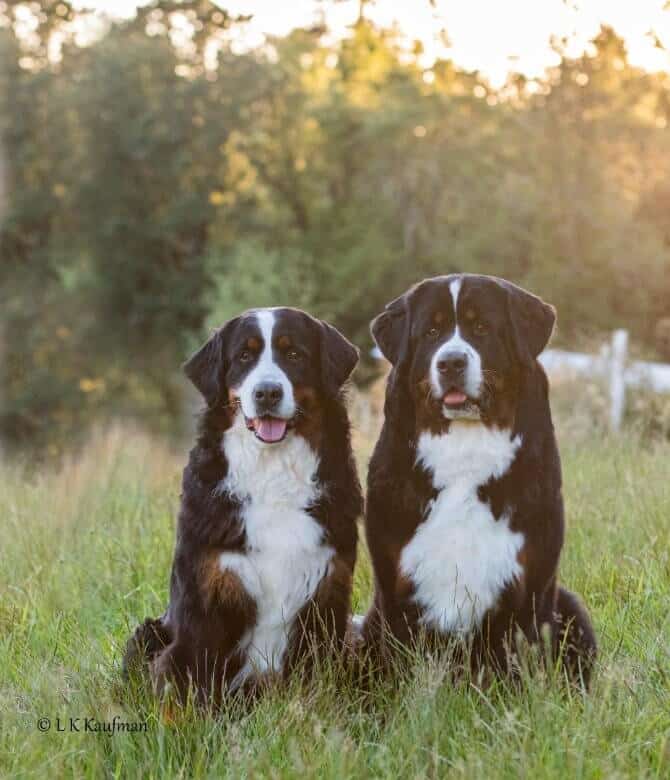
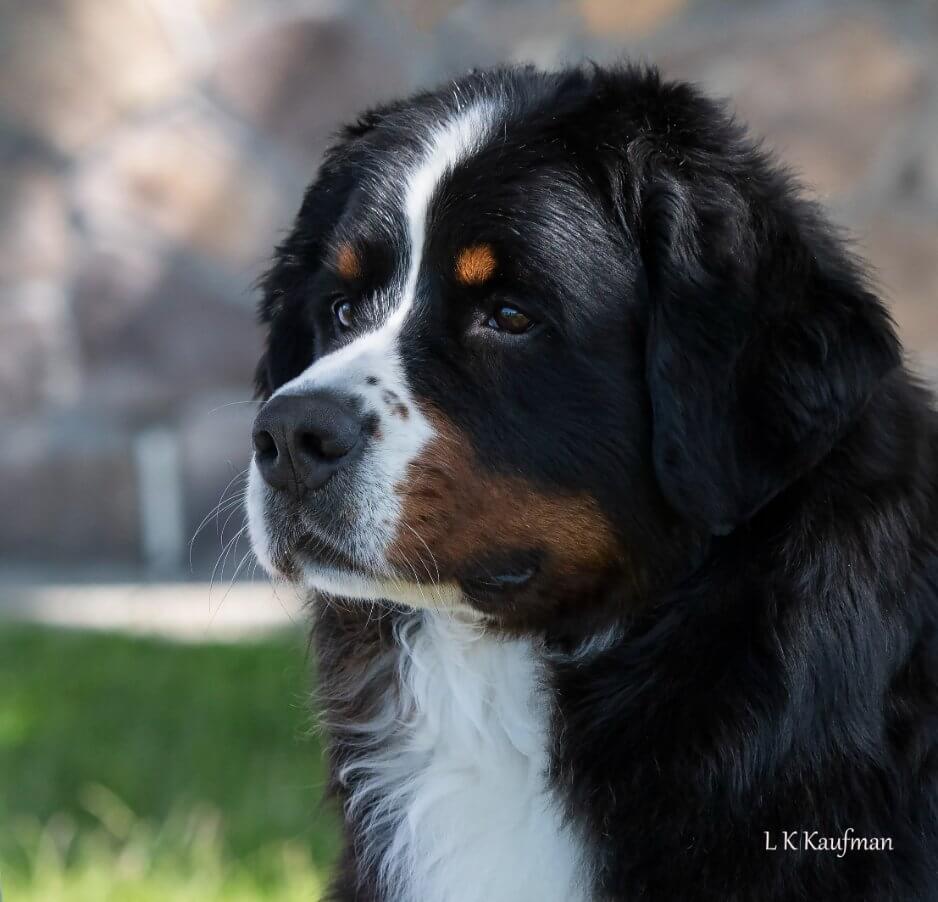
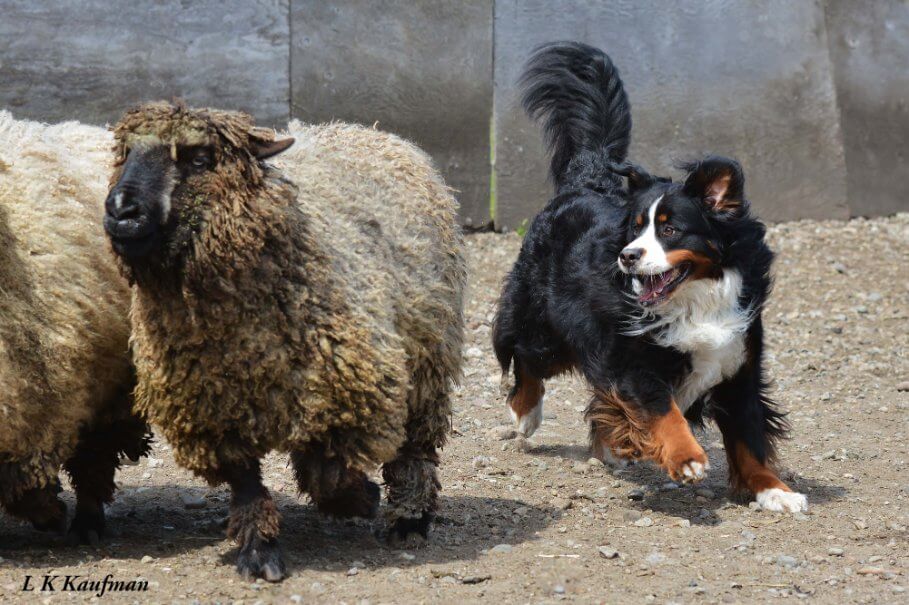
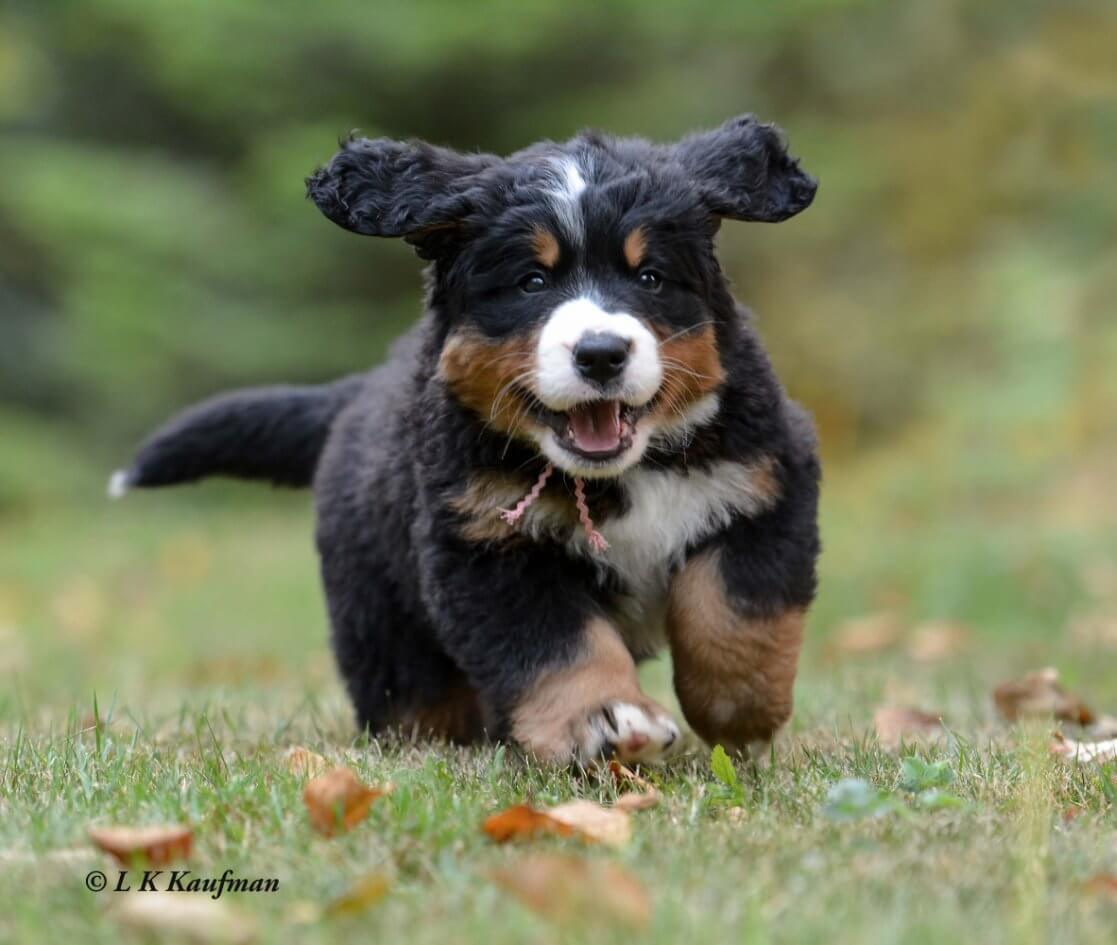

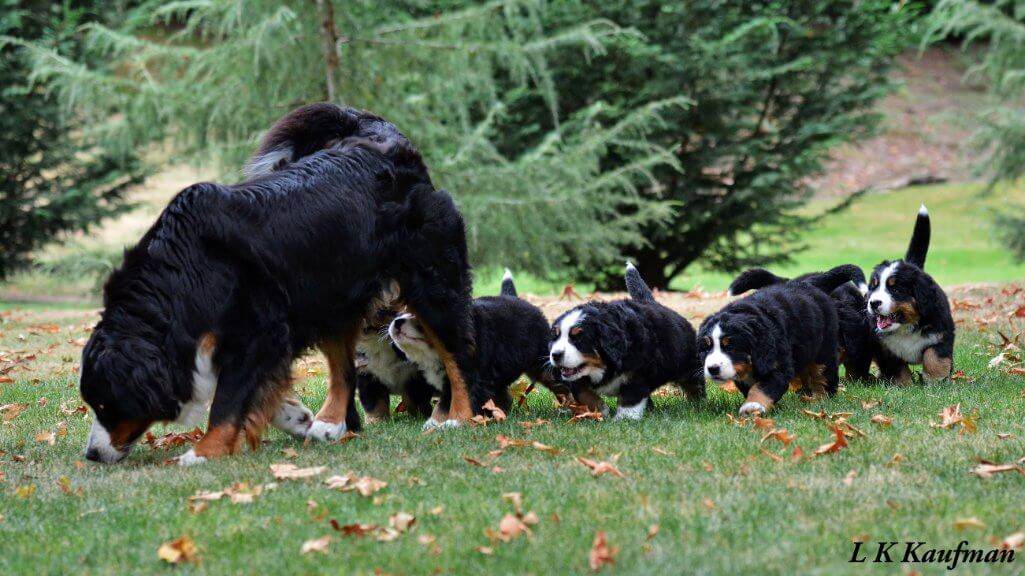
Bernese Mountain Dog Club of America, Inc.
08/04/2025
The Bernese Mountain Dog is a striking. tri-colored, large dog. He is sturdy and balanced. He is intelligent, strong, and agile enough to do the draft and droving work for which he was used in the mountainous regions of his origin. Dogs appear masculine, while bitches are distinctly feminine.
Working
23 – 27.5 Inches
70 – 115 Pounds
7 – 10 Years
| Country of Origin | Switzerland |
|---|---|
| Bred For | General Farm Work, including Drafting and Droving |
| Known For | Gentle Disposition, Friendly with Children and Other Animals, Strong and Willing Worker, Homebodies Who Love their Family |
| Popularity | Growing in popularity, and unfortunately, this has led to exploitation by puppy mills and mixed breedings. The demand outweighs the availability of well-bred animals. |
| Temperament | Self-Confident, Alert, Good-Natured |
| Activities | Versatile for many dog sports. Most popular with owners are Conformation, Drafting, Rally, Obedience, Herding, Scent Work, and Agility. |
The historical essence of the Bernese Mountain Dog is that it has been a farm dog of the midland regions of Switzerland, mostly around the city of Berne. In that capacity, it was primarily used as a companion and watchdog to the farmer and his family. It alerted his owner to unfamiliar visitors. It may have been used as a dog to pull a cart. A large dog, well-muscled and with sturdy bone, was needed for this task. It may have been used to accompany cows to pasture, but not for long distances as dogs which work on a range. As most Swiss farmers had a small number of cows, the dog was not required to manage large herds. The BMD was not a herding dog for sheep and goats, as these animals were not kept usually on Bernese farms except in very small numbers. The temperament of the Bernese Mountain Dog was never to be sharp or shy.
The history of the breed, therefore, is one of a watchful farm dog. Those fanciers who wish to have Conformation dogs or Obedience, Draft, Agility, Tracking, or Herding dogs would be wise to heed the heritage of the breed, and mind that this is not a breed of any one specific sport but is a Swiss farmer’s companion.
Measured at the withers, dogs are 25 to 2.5 inches; bitches are 23 to 26 inches. There are no weight specifications; however, because this is a working dog he should be fit and with well-developed muscles.
Bernese Mountain Dogs are slightly longer in body than they are tall. Sturdy bone is of great importance.
The body is full.
The neck is strong, muscular, and of medium length. The topline is level from the withers to the croup. The chest is deep and capacious with well-sprung ribs. The brisket reaches at least to the elbows. The back is broad and firm, and the loin is strong. The croup is broad and smoothly rounded to the tail insertion.
The shoulders are moderately laid back, flat-lying, well-muscled, and never loose. The legs are straight and strong, and the elbows are well under the shoulder when the dog is standing. The pasterns slope very slightly, but are never weak. Dewclaws may be removed. The feet are round and compact with well-arched toes.
The thighs are broad, strong, and muscular. The stifles are moderately bent and taper smoothly into the hocks. The hocks are well-let-down and straight as viewed from the rear. Dewclaws should be removed. Feet are compact and turn neither in nor out.
Texture: The coat is thick, moderately long, and slightly wavy or straight. It has a bright natural sheen.
| Standard Color | |
|---|---|
| Black Rust & White | ee |
| Black Tan & White | ee |
| Black & Rust | ee |
| Black & White | ee |
| Rust & White | ee |
A Note About Color: The Bernese is tri-colored with ideally symmetrical white markings on the muzzle, white on all four feet and the tip of the tail. Rust separates the black from the white and appears over each eye. The ground color is jet black. Markings are rich rust and clear white.

The tail is bushy and without kinks. It is carried low in repose, and in motion is carried straight off the back or in a slight upward swirl.
The Bernese Mountain Dog is a large, but not giant, dog. Potential owners need to realize that these dogs have abundant coat and shed heavily. This breed also needs to live where you are and should be inside with the family. They do not do well as kennel dogs and should not be left outside alone. They are farm dogs by heritage and, as such, need exercise to stay mentally and physically fit. They love cold weather but can live happily in warmer climates as long as they have an air-conditioned environment. They love cool, hard surface floors and fans. They need regular brushing and the coat is relatively easy to maintain.
Like all breeds, the Bernese have health issues. Most common issues are cancer, hip and elbow dysplasia, bloat, autoimmune diseases, hypothyroidism, and degenerative myelopathy. The Bernese Mountain Dog Club of America and the Berner-Garde Foundation aggressively support ongoing health research, and most breeders are involved in these endeavors. Test results and certifications are available on the Berner-Garde database and should be utilized to get a picture of the health of the pedigree. It is also helpful to find a veterinarian familiar with the breed.
Lifespan: Unfortunately, Bernese have a relatively short lifespan, averaging eight years. However, many live to 10 years and beyond. Potential owners need to be prepared for issues which can be financially and emotionally draining.
Despite their resilience, Bernese Mountain Dogs are prone to certain health conditions, including:
A relationship with the dog’s breeder and regular veterinary check-ups are critical for the early detection of these and other potential health issues. Wellness exams, along with specific tests for the hips, elbows, and eyes, are essential for maintaining their health.
Temperament & Personality: The temperament of the Bernese Mountain Dog is self-confident, alert, and good-natured. He should never be sharp or shy. This is a very friendly breed and is generally good with children and other animals, in keeping with his history as a farm dog. Bernese also excel in Therapy work with proper training.
The best advice an owner can get is from the breeder, and following their lead as to what type of food to feed as well as amounts and how often to feed. Most Bernese do receive some supplements, especially supplementation for joint health. Owners should discuss any issues with food and nutrition with their breeder and veterinarian.
The Bernese is a very versatile dog and can excel in any number of dog sports, including Conformation, Obedience, Rally, Agility, Tracking, Herding, Drafting, Scent Work, and more. Because a puppy will quickly become a large adult, puppy training and socialization classes are strongly encouraged.
Regular exercise is crucial for the Bernese Mountain Dog, not only to maintain their physical health but also to provide mental stimulation and prevent boredom. Due to their size and energy levels, they require a fair amount of exercise, but it should be balanced to suit their physical capabilities and avoid excessive strain, especially on their joints.
| Energy Level | Moderate to High |
|---|---|
| Exercise Requirements | 1.5 Hours/Day (Minimum), Daily Walks, Regular Exercise, Playing with Another Dog, Mental Stimulation |
Daily walks are essential for the Bernese Mountain Dog. These walks not only provide physical exercise but also offer opportunities for mental stimulation and social interaction. The length and intensity of walks can vary, but it’s important to make sure that they are consistent and tailored to the dog’s age and health. Young dogs and puppies, in particular, should not be over-exercised, as their bones and joints are still developing.
In addition to walks, Berners also enjoy other forms of exercise and play. Activities like fetching, gentle tug-of-war, and obstacle courses can provide both physical activity and mental engagement. These activities also strengthen the bond between the dog and its human companion.
Despite their size, Bernese Mountain Dogs are not generally high-energy dogs. Their exercise needs can be described as moderate. However, they do have a playful side and enjoy engaging in interactive play sessions. It’s important to provide a variety of activities to keep them engaged and happy.
When considering exercise for a Bernese Mountain Dog, it’s also important to take into account their adaptability to weather conditions. As a breed with a thick coat, they can enjoy outdoor activities in cooler weather, but care should be taken during warmer temperatures to prevent overheating. Providing ample water and avoiding strenuous exercise in hot weather are essential precautions.
Grooming is an important aspect of caring for a Bernese Mountain Dog, not only for maintaining their striking appearance but also for their overall health. Their thick, long coat requires regular attention to keep it in good condition and to minimize shedding.
| Coat Type | Double, Thick, Moderately Long, Slightly Wavy or Straight |
|---|---|
| Grooming Requirements | Weekly Brushing, Occasional Bathing, Routine Ear Cleaning, Periodic Nail Trimming, Regular Tooth Brushing |
The coat of a Bernese Mountain Dog is dense and can trap dirt and debris, so regular brushing is essential. Brushing several times a week helps to remove loose hair, prevent matting, and distribute natural skin oils throughout the coat, keeping it healthy and shiny. During shedding seasons, typically in spring and fall, more frequent brushing may be necessary to manage the increased shedding.
Bathing the Bernese Mountain Dog is also part of the grooming routine but doesn’t need to be done too frequently. Over-bathing can strip the coat of its natural oils. Bathing every few months or when the dog is noticeably dirty is generally sufficient. Using a dog-specific shampoo will help maintain the health of their skin and coat.
In addition to coat care, other grooming tasks are important for the Bernese Mountain Dog. Regular nail trimming is necessary to prevent discomfort and potential health issues. Their nails should be trimmed every month or as needed.
Ear care is also crucial, as their floppy ears can be prone to infection. Checking and cleaning their ears regularly helps prevent the buildup of wax and debris, which can lead to infections.
Dental hygiene is another important aspect of grooming. Regular teeth brushing, along with dental chews and regular check-ups with a veterinarian, can help prevent dental disease, which is common in many dog breeds.
Living with a Bernese Mountain Dog can be a highly rewarding experience, but it comes with certain considerations to maintain the happiness and health of both the dog and its human companions.
Berners, despite their large size, can adapt well to various living environments, including apartments, provided they receive enough exercise. However, they are best suited to homes where they have ample space to move around, such as a house with a yard. Their size and energy levels mean they need room to play and exercise daily.
When it comes to weather adaptability, the breed’s thick coat makes them well-suited for cooler climates. They generally enjoy spending time outdoors in cold weather, often finding snow particularly invigorating. However, due to their heavy coat, they can be prone to overheating in hot weather. It’s important to provide them with a cool, shaded place to rest during hot days and to limit their exercise to cooler periods, such as early morning or evening.
Their social nature means Bernese Mountain Dogs thrive on companionship and do not do well when left alone for extended periods. They are happiest when they can be part of family activities. Prolonged solitude can lead to anxiety and behavioral issues. Therefore, they are best suited to households where someone is home for most of the day or can take the dog with them on outings.
Finding a Puppy: Bernese Mountain Dogs have become a very popular dog to own and the demand certainly exceeds supply, especially from reputable breeders. The BMDCA compiles a list of breeders in good standing with the club, who are currently breeding and may have puppies available, in their Online Breeder Referral which can be found on their website: BMDCA.org. As has happened in many breeds, puppy mills, pet stores, and online advertisers are trying to exploit the breed. Likewise, cross-breeding has become far too common, with buyers unknowingly spending exorbitant prices for nothing more than a mixed-breed with unknown and unpredictable temperament, health, and physical characteristics.
Potential owners need to do their research, and identify and work with responsible breeders. At a minimum, a responsible breeder will assist to help identify if the BMD is the right breed for the inquiring owner, provide lifelong support for both owners and their dog, provide verification of health testing of dogs in the pedigree, and provide a contract covering purchase requirements and the responsibilities of both breeder and owner.
As with all puppies, Bernese need a secure environment, puppy kindergarten training classes, a quality diet with appropriate calories to support their rapid growth, regular visits with an experienced veterinarian, which includes core vaccinations, socialization with different people and animals, and plenty of fresh air and play exercise. It is important to not ever force exercise, as it is easy for a large puppy to injure himself. Until the puppy is a year of age, it is wise to not allow access to stairs and to limit exercise to natural terrain, avoiding cement and asphalt. Please refer to the BMDCA Info Series available on BMDCA.org for more ideas and information.
As mentioned earlier, Bernese are strong, agile, and versatile athletes. In keeping with their heritage, the Bernese Mountain Dog Club of America has developed an extensive Draft Dog program. Dogs are eligible to participate in the tests after the age of two years. Tests are held throughout the year, hosted by regional BMD clubs and the BMDCA. Titles are awarded for Novice Draft Dog, Open Draft Dog, Brace Novice Draft Dog, and Open Draft Dog. Awards are also earned for multiple titles, culminating with Grand Master Draft Dog. In addition, many Berners excel in all other AKC performance sports. It is of utmost importance that all Bernese be kept in well-muscled physical condition, but especially those competing in draft tests and other dog sports.
The Bernese Mountain Dog is recognized by the world’s leading registries and kennel organizations, which categorize the breed into a specific Group based on its unique characteristics. This breed is recognized worldwide under the following Group designations:
| Organization | Group Designation |
|---|---|
| AKC (American Kennel Club) | Working |
| UKC (United Kennel Club) | Guardian |
| CKC (Canadian Kennel Club) | Working |
| ANKC (Australian National Kennel Council) | Utility |
| RKC (The Royal Kennel Club) | Working |
| FCI (Fédération Cynologique Internationale) | Group 2: Pinscher and Schnauzer Type – Molossoid Breeds – Swiss Mountain and Cattle-Dogs; Section 3: Swiss Cattle Dogs |
The ideal Bernese Mountain Dog is described by a Breed Standard that is approved by each of the world’s leading registries and kennel organizations. The Breed Standards for this breed may be found in the following links:
| Organization | Breed Standard |
|---|---|
| American Kennel Club | AKC Bernese Mountain Dog Breed Standard |
| United Kennel Club | UKC Bernese Mountain Dog Breed Standard |
| Canadian Kennel Club | CKC Bernese Mountain Dog Breed Standard |
| Australian National Kennel Council | ANKC Bernese Mountain Dog Breed Standard |
| The Royal Kennel Club | RKC Bernese Mountain Dog Breed Standard |
| Fédération Cynologique Internationale | FCI Bernese Mountain Dog Breed Standard |
At present, there are 28 regional Bernese Mountain Dog clubs in the US. The areas served and contact information are listed on the Regional Clubs page of the national club website.
There are rescue groups for the breed throughout the country. Most regional clubs have associated rescue groups, and the national Rescue Committee provides rescue information and can be contacted through the national club website.
Yes, Bernese Mountain Dogs shed. They have a thick, long double coat that sheds throughout the year, with heavier shedding typically occurring during the spring and fall. Regular grooming, including brushing several times a week, is necessary to manage their shedding and to keep their coat healthy.
An adult male Bernese Mountain Dog usually reaches a height of about 25 to 27.5 inches at the withers, with the female being somewhat smaller, typically ranging from 23 to 26 inches in height. In terms of weight, a male Berner often weighs between 80 to 115 pounds, while the female, being smaller, usually weighs around 70 to 95 pounds.
Bernese Mountain Dogs have a relatively short life expectancy compared to other breeds, typically ranging from 7 to 10 years. This shorter lifespan is partly due to their large size and some breed-specific health issues. Proper care, a healthy diet, and regular veterinary check-ups can contribute to a longer and healthier life.
Bernese Mountain Dogs are known for their intelligence and eagerness to please, which makes them relatively easy to train. They respond well to positive reinforcement techniques. Their smart and gentle nature makes them excellent companions, especially in activities that require cooperation and learning.
Bernese Mountain Dogs can drool, especially in anticipation of food, during exercise, or when they are overheated. However, they are not known to be excessive droolers like some other large breeds. Keeping them well-hydrated and cool can help to minimize the drooling.
Bernese Mountain Dogs originate from Switzerland, specifically from the canton of Bern. They were originally bred as farm dogs in the Swiss Alps where they were used for herding cattle and pulling carts, and as a general farm dog. Their history in the alpine region significantly influenced their development.
No, Bernese Mountain Dogs are not hypoallergenic. They shed their thick, long hair regularly, which can be a concern for people with allergies. Regular grooming can help to manage the shedding, but they are not an ideal breed for those seeking a hypoallergenic dog.
Bernese Mountain Dogs were originally bred for work on farms in the Swiss mountains. Their primary roles included pulling carts, herding livestock, and serving as watchdogs. Their strength, endurance, and gentle temperament made them well-suited for these tasks.
Bernese Mountain Dogs have a natural protective instinct, especially towards their family. They are typically alert and vigilant, making them good watchdogs. However, they are known more for their gentle and friendly demeanor rather than being overly protective or combative.
Bernese Mountain Dogs are generally not aggressive; they are known for their calm and gentle temperament, and are typically good-natured and friendly. Even with strangers, they tend to be welcoming and are well-suited for homes and businesses that receive visitors. Proper socialization and training from a young age can help them remain well-behaved and sociable.
Bernese Mountain Dogs are generally very good with kids. They are generally acknowledged for their gentle, patient, and protective nature, making them excellent family pets. Their size might be intimidating, but they tend to be careful and kind around children,. However, as with any large breed, supervision around small children is always advised.
Bernese Mountain Dogs can enjoy water, though this can vary by individual. Some Berners love swimming and playing in water, while others can be more hesitant. Introducing them to water in a positive, gentle way from a young age can help them become comfortable and enjoy water-based activities.
The relatively short lifespan of the Bernese Mountain Dog, typically 7 to 10 years, is influenced by a variety of factors that include the breed’s large size. Large dog breeds often have shorter lifespans than smaller breeds. Additionally, the Berner is prone to certain health conditions, which can impact their overall longevity.
Bernese Mountain Dogs do not generally bark excessively. They may bark to alert their human companions to something unusual, but they are not known for being noisy. Proper training and socialization from a young age can help them understand when barking is appropriate and when it is not.
Bernese Mountain Dogs can be good with cats, especially if they are raised with them from a young age. Their gentle nature often extends to interactions with other pets. However, as with any dog, individual temperaments can vary, and proper introductions and socialization are important.
Bernese Mountain Dogs are capable swimmers, but their affinity for water can vary individually. They should be introduced to swimming in a safe and controlled environment. And although their thick coats provide a bit of buoyancy, care should be taken to make sure that they don’t overheat or become overexerted while swimming.
Bernese Mountain Dogs typically stop growing in physical size by about two to three years of age. However, they may continue to fill out and gain muscle mass beyond this age. To ensure healthy development, it is important to monitor their diet and exercise during the growth phase.
While Bernese Mountain Dogs can be alert and vigilant, making them decent watchdogs, they are not typically suited as guard dogs due to their typically friendly and gentle nature. They are more likely to greet strangers with a wagging tail rather than with suspicion.
Bernese Mountain Dogs are excellent family dogs. They are known for their affectionate, loyal, and gentle temperament, which makes them great companions for families. Their patience and protective instincts also make them particularly good with children.
Bernese Mountain Dogs can be a good choice for first-time dog owners, provided those owners are prepared to handle a large breed. These dogs require regular grooming and exercise, and training them from a young age is important. Their friendly and easy-going nature can make the training process enjoyable for even inexperienced owners.

The Bernese Mountain Dog Club of America (BMDCA) was founded in 1968 for the advancement of the Bernese Mountain Dog. The BMDCA is the parent breed club for the Bernese Mountain Dog and is a member of the American Kennel Club. The BMDCA has many Regional Bernese Mountain Dog Clubs that create a network of support for Bernese Mountain Dog owners.
Members include breeders, owners and fanciers who are committed to protecting the health, welfare, and lives of the Bernese Mountain Dog. Regional Clubs offer meetings, matches, Draft Tests, BMDCA Regional Specialties, and educational programs. The BMDCA and Regional Clubs actively support canine health research and provide rescue assistance for Bernese Mountain Dogs through the National Regional Club Rescue and Regional Club programs.

Explore the draft heritage of the Bernese Mountain Dog. Learn how to start: Draft tests, drafting equipment such as carts, harnesses and more.

Passionate Bernese Mountain Dog breeder Summer Ory shares insights on health, type, and responsible breeding practices.
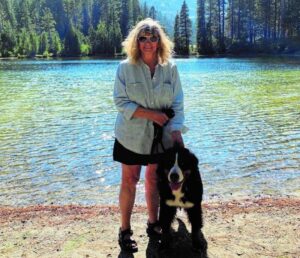
Bobbie Hefner is the breeder behind Swiss Star Farms’ Bernese Mountain Dogs. Read about the kennel’s beginnings, champions, puppies and more!
The best way to ensure a long and happy relationship with a purebred dog is to purchase one from a responsible breeder. Not sure where to begin?
Contact the National Parent Club’s Breeder Referral Program, which is listed on the AKC Breeder Referral Contacts page.
